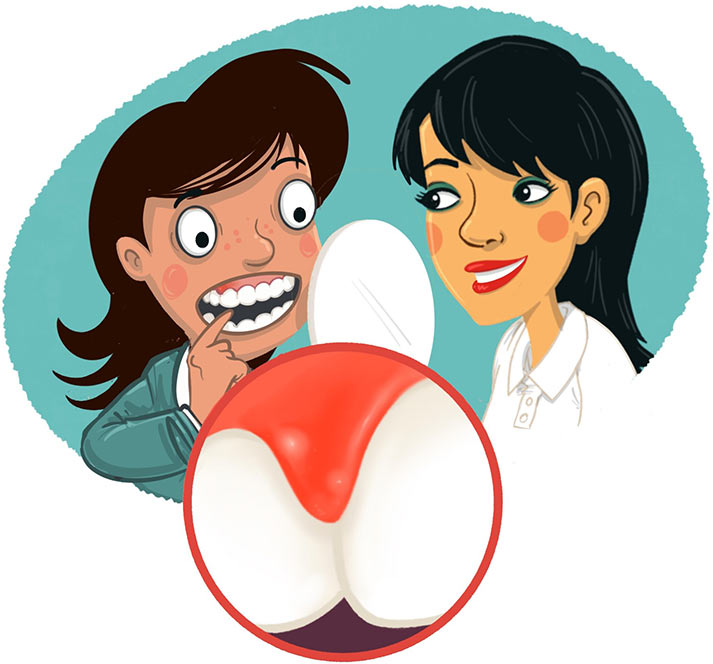Gingivitis Treatment for Kids and Teens
 Healthy gums are usually pink in color and do not bleed during tooth brushing or flossing. Gingivitis, or inflammation of the gums, is manifested by swollen, reddened gums that easily bleed during tooth brushing or flossing. The gums may be tender and painful to touch.
Healthy gums are usually pink in color and do not bleed during tooth brushing or flossing. Gingivitis, or inflammation of the gums, is manifested by swollen, reddened gums that easily bleed during tooth brushing or flossing. The gums may be tender and painful to touch.
Inflammation is caused by bacteria that form a sticky biofilm (or, plaque) along the gumline, causing the gums to become reddened and swollen.
Plaque is composed of bacteria, mucus, and food debris ; if not removed, it turns into a hard deposit called tartar (or, calculus) that is trapped at the base of the tooth, irritating the gums. Inflamed gum tissue may separate from the neck of the tooth, forming small gaps or pockets between the teeth and the gums.
Bacteria settle in these pockets and therein produce digestive enzymes and endotoxins to promote inflammation. If gingivitis proceeds unchecked, the pockets open up between the gums and the teeth, exposing the roots of the teeth. Bacteria may occupy those spaces and cause decay in the roots of the teeth.
Read more about early childhood cavities, how to prevent cavities in kids and teens the latest treatment called Silver Diamine Fluoride Treatment (SDF).
Periodontal disease develops when bacteria in the gum pockets adversely affect the periodontium, the specialized tissue that supports and maintains the teeth. Upon further inflammation and destruction of the periodontium, the teeth can gradually become loose and fall out or need to be removed. Persistent bad breath is an indicator of periodontitis.
How to Prevent Gingivitis?
Regular oral hygiene, including brushing and flossing, is the best defense against gingivitis. There is some evidence that flossing in conjunction with toothbrushing reduces gingivitis to a greater extent than tooth brushing alone.
Other studies showed a greater reduction in plague and gingivitis upon using a powered/electric toothbrushes as compared to manual toothbrushes. There is evidence that toothpaste containing fluoride was effective in preventing gingivitis.
Mouthwashes with antimicrobial agents, such as hydrogen peroxide, triclosan, and chlorhexidine digluconate, are also effective therapies against gingivitis. Mouthwashes with essential oils were approved by the American Dental Association as plaque reducers and as anti-inflammatory agents, such as:
- methyl salicyclate
- eucalyptol
- menthol
- thymol,
Mouth washing with warm salt water may alleviate gum swelling.
Read more on how to prevent and treat Gingivitis (Gum Disease) in children.
Does a Dental Cleaning Remove Tartar?
Professional dental cleaning is required for removal of tartar, by scaling and root planning.
Scaling is the procedure in which tartar and bacteria are removed from tooth surfaces and from beneath the gumline. Root planning is a more aggressive procedure that involves instrumentation, a laser, or an ultrasonic device. These procedures remove bacterial metabolic products causing inflammation and smoothes root surfaces.
Young children may need supervision or assistance with their brushing technique. Older children and young adults may be more susceptible to gingivitis as they often have orthodontic appliances that make be more challenging to maintain proper oral hygiene.
Do you have any questions about the gingivitis treatment for kids and teens we offer in NYC? Would you like to schedule an appointment with the top New York City gingivitis specialist Dr. Sara Babich? Please call our office at 212-988-4070 or visit our kids dentistry center in Manhattan on Upper East Side.
Pediatric Dentistry: Dr. Sara B. Babich, DDS
116 E 84th St
New York, NY 10028
(84th St. btw Park Ave / Lex Ave)
☎ 212-988-4070
 Contact us today to learn more about our
Contact us today to learn more about our New York City pediatric dentistry practice
 (212) 988-4070
(212) 988-4070